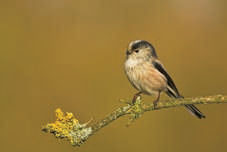The importance of Cheshire and Wirral in national terms

The Wren is our most widespread breeding species.

Small insectivorous resident species such
as Long-tailed Tits have considerably
expanded their range and population since
our First Atlas.
One measure of the importance of the county in national terms is the proportion of the UK's breeding bird population that is in Cheshire and Wirral, bearing in mind that the county covers 1% of the land area of the UK. Using the same methodology as for the county population, national population estimates have been derived (Newson et al. 2008) and Table 4 ranks species in terms of the percentage of the UK population. There are quite large error bars on these proportions and the fine differences should not be taken too literally, but they do indicate some general trends.
The importance of the county for Grey Heron is explained in the species text: with two of the country's five largest heronries and the most ponds per county, it is not surprising that this species ranks so highly. Most of the other species that breed on small waterbodies are also disproportionately present in Cheshire and Wirral, including Canada Goose, Mallard, Moorhen and Coot in this list. The preponderance of livestock in the agricultural scene probably accounts for the presence of several of the species that feed on flying insects, Swift, Swallow, House Martin and Pied Wagtail. The pastoral landscape may also be reasonably good for birds that take earthworms and other soil invertebrates, including Lapwing, Blackbird, Mistle Thrush and perhaps Kestrel, Starling and Jackdaw. But the presence of others on this list is puzzling and would repay in-depth study. Nuthatch and Treecreeper are unexpected in our relatively unwooded county, as is the presence of three warblers in this list.
At the other end of the range, species with a low proportion of the national totals include Coal Tit and Goldcrest, which are much more numerous in the parts of the country with coniferous forests.
Table 4: The proportion of the UK breeding population in Cheshire
and Wirral. From the population estimates derived as detailed in
Appendix 1, this table lists the top 30 species in terms of the
percentage
of the UK total. The figures were calculated to two
decimal places but
are
rounded here to one decimal place
for presentation.
| Position | Species | Percentage of UK breeding population |
|---|---|---|
| 1 | Grey Heron | 4.2 % |
| 2 | Nuthatch | 3.9 % |
| 3 | Long-tailed Tit | 3.6 % |
| 4 | Lesser Whitethroat | 3.4 % |
| 5 | Canada Goose | 2.8 % |
| 6 | Jay | 2.6 % |
| 7 | Kestrel | 2.6 % |
| 8 | Lapwing | 2.5 % |
| 9 | Moorhen | 2.2 % |
| 10= | Chiffchaff | 2.2 % |
| 10= | Swift | 2.2 % |
| 12 | Mallard | 2.2 % |
| 13 | House Sparrow | 2.0 % |
| 14 | Treecreeper | 2.0 % |
| 15 | Pied Wagtail | 2.0 % |
| 16= | Coot | 1.9 % |
| 16= | Swallow | 1.9 % |
| 18 | Blackbird | 1.8 % |
| 19 | Great Tit | 1.8 % |
| 20 | Robin | 1.8 % |
| 21 | Blue Tit | 1.7 % |
| 22 | Dunnock | 1.6 % |
| 23 | House Martin | 1.6 % |
| 24 | Wren | 1.6% |
| 25 | Goldfinch | 1.6% |
| 26 | Carrion Crow | 1.5 % |
| 27 | Starling | 1.5 % |
| 28 | Mistle Thrush | 1.4 % |
| 29 | Garden Warbler | 1.4% |
| 30= | Collared Dove | 1.3 % |
| 30= | Jackdaw | 1.3 % |

